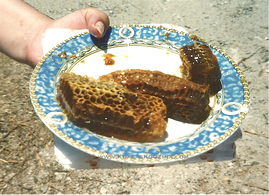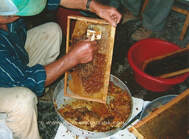Our Taste of Honeyed Nectar
|
When my sister Joanne went to Karpathos a few years ago and told our cousin’s husband Vangeli (Βαγγέλη) that she wanted to see where and how their honey was made. He brought her to this remote place in the mountains (vouna, βουνά) and, as luck would have it, just as they arrived, so did the bee harvesters.
They removed the honeycombs from their truck, with a few bees still attached, and brought them into a tiny structure. They began by scraping off some of the honey from the combs into vats (Joanne guessed that it was the excess) and then placed the combs in huge drums that spin the honey out of them. One of the men gave her a piece of honeycomb to try it. This was her first time eating raw honey off a comb so she asked him “how do you eat it.” They all told her to put the comb in her mouth and treat it like gum. So here goes, she thought, and dove in. The honey oozed out and the comb was like wax (which you spit out when you’re done). She beamed “It was the most delectable honey I had ever tasted. Light, airy, not sugary sweet like the ones you buy in the supermarket.” Her husband, Vinnie, wouldn't try it (not the adventurous type) because he thought they would get botulism (which didn't happen). Their daughter Jackie, who was only 4½ at the time, didn't want to chew the wax so she hesitantly and skeptically put some honey on her tongue and a smile bloomed from ear to ear …an undeniable stamp of approval. “It was sweet, fresh, and warm,” she said, “a one-of-a-kind honey.” |
 a taste of honey on the comb
a taste of honey on the comb
“We were walking in the town and Vangeli specifically wanted us to go into what was like this general [food] store and behold another cousin!” Joanne shared, thinking that they seemed to be darting out of every corner. If you wanted to avoid them, which luckily she didn’t, you’d have to get off the island (but even then there were no guarantees). “We talked for a bit while Vinnie perused the shop,” she continued, “and he came upon a large can of thyme honey that said ‘Made in Olympos’ (a mountain village in Karpathos) with the name George Halkias on the label. Since our grandfather’s side of the family was named Halkias and most of the cousins we met were a Halkias, immediately we both think, Hey, we’re related to him!...our uncle was even named George Halkias. So I asked Vangeli about this ‘relative’ and his astounding, nonchalant reply was "Oh no, no, we aren't related to them." This, after an entire day of finding cousins in every crevice, I thought, how is it possible that we are on the same Island where our grandparents are from, and he’s named Halkias, and we aren't related?? Well, we just weren't, or so he said…then we figured maybe the name Halkias was like Jones or Smith here. We concluded there must have been a bit if inbreeding going on, and at sometime, somewhere, on someone’s family tree we are related.”
After all this commotion that started over a can of honey, the shop owner-cousin gave them the honey as a gift to take home. Sweet! Joanne shared the honey with me when she returned and it was the best I had ever tasted…I only wish I were there to taste it fresh off the honeycomb!
Honey Picks
|
Karpathian honey is not widely exported but a close second is thyme honey from Crete, which is available in Greek grocery stores and Mediterranean shops, as well as online. Our favorite is honey with mastic from 776 Deluxe Foods, flavored with a drop of masticha oil extracted from the sap of the mastic tree. The aroma has an herbal-pine scent that makes this luscious one-of-a-kind honey lovely on its own, or add to lemonade, ice cream, or drizzle over fresh figs for a pop of Greek flavor! Another favorite is Cretan Monastiri honey, a pure "anthomelo" (ανθόμελο) that is produced from the nectar of flowers located in remotely populated areas on the island. Monastiri beekeepers position their hives on the rocky, windswept hills of the island, as they have for 3,000 years. The honey is harvested, aged, filtered, and cleared naturally, without the use of any preservatives. The resulting honey embodies a subtle thyme aroma and an intense floral aftertaste, perfect in teas, over yogurt, and on toast, as well as for cooking.
|
Monastiri honey is minimally processed so it crystallizes naturally. To return a honey to its liquid form, gently heat it by placing the opened jar in a pan of hot water over low heat just until the crystals liquefy, 10 to 15 minutes, being careful not to overheat. It should be stored at room temperature (not refrigerated) away from sunlight and heat.

Honey Glazed Gorgonzola-Stuffed Figs with Pancetta

Serves 4
Serving size: 2 figs 8 slices pancetta, or thick-cut bacon 8 fresh figs 6 ounces Gorgonzola cheese, crumbled 4 ounces Ariadne Pure raw (Mellona) Honey 1. Preheat oven to 450°F. Arrange pancetta on a rimmed baking sheet and bake until it just starts to brown but is still flexible (do NOT overbake), about 5 minutes. Transfer pancetta to a paper towel-lined plate and let cool slightly. Drain excess drippings from baking sheet but do not wash. 2. While the pancetta is baking, trim the stem of each fig and cut an “X” into the tops, slicing ¾ of the way down, keeping the base of the figs intact. Gently open the figs and stuff each with cheese. Reshape figs and wrap with pancetta, sealing in the cheese. Secure the pancetta to each fig by pushing a toothpick into the pancetta outer loose end and through the other side of the fig. 3. Warm the honey spread and coat the outside of the wrapped figs. 4. Place figs 1 inch apart, stem end up, on the baking sheet and bake until the pancetta is golden brown and crisp, about 5 minutes. Remove toothpicks and transfer figs to serving plates. Serve warm with a light salad, if desired. © Recipe by Chef Chris Smith, created for the Cyprus Embassy Trade Commission |
Shop it!
igourmet.com, DeMedici, and select Whole Foods Markets
MONASTIRI thyme honey from Crete:
Titan Foods
Mediterranean Foods
ARIADNE PURE (Mellona) from Cyprus:
ariadnepure.com
I hope you enjoyed our personal taste of honey. Read about the history of honey in our blog Honey~An Ancient Treasure. For more on the foods of Karpathos, see our blog Greek Cooking with a Karpathos Island Twist. Stay tuned for more Karpathian flavors in upcoming blogs.
Sign up for our e-newsletter (if you haven’t already) and stay connected on social media for cooking tips and recipes, as well as for all Kukla's Kouzina updates and news.
Thanks for following us and we’ll see you next Monday!
Until then~
Kali orexi! Good appetite!
Kelly
ALERT: Special attention should be given to the fact that bee colonies are collapsing and certain bee species, like the patched bumblebee, are in danger of extinction. The recent rise in bee deaths has been linked to increased use of pesticides and insecticides in the United States. If the bees die, we eventually die. To learn more about this crisis and what you can do, visit NRDC. Together, we can save the bees!
Web design by Kelly Salonica Staikopoulos
















